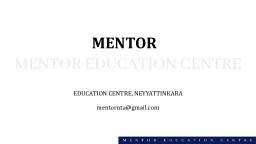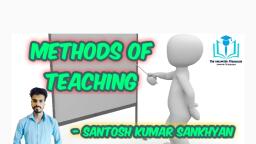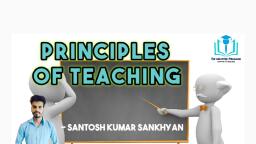Page 2 :
Handwritten Notes, Paper 1, , Paper 2, (Management), , Soft Copy, , ₹ 100, , ₹ 300, , Hard Copy, , ₹ 150, , ₹ 450, , Call or Whatsapp for Notes : 7627096162, Note : Paper 1 includes 7 units except Comprehensions, Numerical Reasoning, and Data Interpretation because these units are practice based and theoretical, part of these units is covered in notes., For hard copies postal/courier charges are separate.
Page 3 :
Instructional Facilities, The teaching instructional facilities include audio-visual instructional facilities. They follow the, assumption that learning originates from senses’ experience. They help in better learning, retention, and recall, thinking and reasoning, activity, interest, imagination, better assimilation and personal, growth and development., The main benefits of instructional facilities, also known as Teaching Learning Materials (TLMs) are, as follows :, , o Motivation to Learner, o Maximum utilization of resources, o Better retention of information, o Helps in changing attitude, o Practical Application, o Making learning fun, o To facilitate hostile learning
Page 4 :
Types of Teaching Aids/Instructional Facilities, According to the senses involved : The educational technology can be divided into audio, video, and audio-video instructional facilities., , Audio instructional facilities : They are instructional devices through which message can only be, heard. Examples of audio instructional facilities include language labs, radio sets, sound, distribution sets, etc., , Visual instructional facilities : Instructional devices through which the message can only be seen, are known as visual instructional facilities. Examples include posters, flashcards, charts, bulletin, boards, maps, models, photographs, etc., , Audio–visual instructional facilities : They are instructional devices in which the message can be, heard and seen simultaneously. Out of five senses, seeing at 87% and hearing at 7% are the major, ones to attract attention and increase learning. Examples of audiovisual instructional facilities, include television, video films, documentary films, etc.
Page 5 :
Types of Teaching Aids/Instructional Facilities, Functions of Audio – Visual Teaching Aids :, , , , , , , , More clarity and understanding., Better attention, interest and retention., It helps in faster and comprehensive learning., Better access., Save the instructor’s time., Supplement the spoken words by combining audio and visual stimuli., , Limitations of Audio – Visual Teaching Aids :, Learners may form distorted impressions unless audio-visual instructional facilities are, supplemented with required explanations., Teaching may be narrowed down to only a few big ideas, not giving the complete picture of a, subject., There is the possible risk of spectators instead of the attitude of thoughtful enquiry. Some, extension workers acquire the mistaken idea.
Page 6 :
Types of Teaching Aids/Instructional Facilities, According to the Projection or Show : Teaching instructional facilities according to projection, or show are divided into projected and non- projected instructional facilities., , Projected instructional facilities : Visual instructional devices that are shown with a projector are, called projected instructional facilities. Examples include slides, filmstrip, silent films, cartoons,, etc. These are projected through an opaque projector (epidiascope) or an overhead projector., , Non-projected instructional facilities : Visual instructional devices that are simply presented, without any projection equipment are non-projected instructional facilities. Examples include, blackboard, chart, etc.
Page 7 :
Types of Teaching Aids/Instructional Facilities, Projected instructional facilities, , Films, Slides, Overhead Projectors, Epidiascope, Video Projectors, Film Strips
Page 8 :
Types of Teaching Aids/Instructional Facilities, Non - Projected instructional facilities, , Graphics, Charts, Flash Cards, Posters, Pictures, Graphs, Maps
Page 9 :
Types of Teaching Aids/Instructional Facilities, Non - Projected instructional facilities, , Display Boards, Blackboard, Whiteboard, Bulletin Boards, Flannel Board, Magnetic Board, Peg Board
Page 10 :
Types of Teaching Aids/Instructional Facilities, Non - Projected instructional facilities, , 3-D, Models, Mock – ups, Objects and Specimens, Puppets
Page 11 :
Types of Teaching Aids/Instructional Facilities, Non - Projected instructional facilities, , Audio, , Activity, , Radio, , Field Trips, , Recordings, , Experimentation, , Digital Audio Players, , Dramatics, , Telephones, , Teaching Machines, , Mobiles, , Programed Instructions
Page 12 :
Factors affecting the Selection of, Teaching Aids/Instructional Facilities, Audio-visual instructional facilities are used singly or in combination, thereby taking into, consideration the following factors., Nature of audience : Printed media are meant for literate people, whereas exhibits, pictures and, symbols are for less literate people, Size of audience : A video show or whiteboard cannot be used effectively when the number of, participants exceeds 30 and internet can be used for large audiences., Teaching objective or expected nature of change : Select the audio-visual instructional facilities, based on the objective of extension teaching, i.e., to bring about a change in (a) Thinking or, knowledge (b) Attitude or feeling (c) Actions or skills., Availability of instructional facilities : With the availability of speed, due to better technology and, cost effectiveness, more people are now using internet-based technologies as teaching instructional, facilities., Relative cost : The amount expended on audio-visual instructional facilities, in relation to the, extent of effectiveness is also an important consideration in their selection and use.
Page 13 :
Dale’s Cone of Experience, During 1960s, Edgar Dale theorized that learners retain more information by what they ’do’ as, opposed to what is ‘heard’, ‘read’, or ‘observed’. His research led to the development of the ‘Cone of, Experience’. Today, this ‘learning by doing’ has become known as ‘experiential learning’ or ‘action, learning’.
Page 14 :
Teaching Support System, Teacher Support System is basically a set of tools that helps to improve student achievement by, building newer capacities in the teachers. It can be taken as kind of process as well, it influences the, way decisions are made and what information is passed on. This helps us to know that how teachers, acquire new skills and increase student achievement in areas they are under performing. It happens, with help from technology and traditional support system also., Traditional v/s Modern Methods :, Traditional is basically teacher centered instruction and modern is students’ centric approach., In traditional approach, memorization of facts, objective information; correct knowledge is, paramount. In modern approach, understanding the facts, Application of facts, Analysis,, Evaluation, Innovation; Critical thinking is paramount, Traditional approach aims at high test scores, grades and ultimately degrees. Modern approach, aims at Learning, retention, accumulation of valuable knowledge & skills., In traditional methods, students matched by age, ability etc., while modern and possibly also by, ability., The teacher relies on textbooks, lectures, and individual written assignments etc. In modern, teaching, practicality, discoveries, group activities are the main pillars.
Page 15 : Thanks for Watching, Like, Comment, Subscribe and Share, , “The Unlimited Struggler”, , Contact Details :Email :
[email protected], Call & Whatsapp : 7627096162, (Hard/Soft copy of Hand Written notes also available on paid basis)























































































